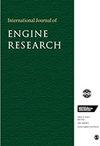Spray formation and spray-wall-flow interaction in a gasoline direct-injection (GDI) engine under early-injection conditions: A flow bench study
IF 2.1
4区 工程技术
Q2 ENGINEERING, MECHANICAL
引用次数: 0
Abstract
The work presented in this study aims to understand the spray-wall-flow interaction within a gasoline direct-injection (GDI) engine flow bench under simulated early-injection conditions. The Engine Combustion Network (ECN) Spray G injector is installed in the Darmstadt optically accessible engine flow bench. Under simulated early-injection conditions, the formation of a multi-hole spray and the interaction with characteristic intake flows, such as the intake jet and central tumble flow, are extensively discussed. By reducing the complexity in the number of variables inherent in engine flow and whole-engine simulation, an engine flow bench operating under various mass flow rates is applied in this study. The numerical simulation is carried out using Large Eddy Simulation (LES) under the Eulerian-Lagrangian framework for spray simulation. Experimental data, acquired through particle image velocimetry (PIV) measurements, provides 2-D flow fields on both the central tumble and valve planes, facilitating the validation of in-cylinder flow fields. Furthermore, experimental data obtained through Mie scattering is utilized to investigate spray formation and evolution within the GDI engine, providing the liquid penetration length and liquid spray angle. Comparison between the numerical and experimental data demonstrates several agreements. Moreover, the variation of different spray plumes under different mass flow rates is observed in the case of both experimental and numerical data. Increasing the mass flow rate distorts the overall plume shape and shifts it away from the intake port. This phenomenon is examined by extracting the liquid volume fraction and vapor fields of each plume. Spray plumes encounter different convective disturbances and evaporation due to their local characteristic in-cylinder flow. Furthermore, spray-wall-flow interaction and wall film deposits are observed during the injection. Lastly, the influence of the spray-induced turbulence is analyzed under different mass flow rates.汽油直喷(GDI)发动机在早期喷射条件下的喷雾形成和喷雾壁与气流的相互作用:流动工作台研究
本研究旨在了解汽油直喷(GDI)发动机流动台在模拟早期喷射条件下的喷射壁-流动相互作用。发动机燃烧网络(ECN)Spray G 喷油器安装在达姆施塔特可视发动机流动台上。在模拟早期喷射条件下,对多孔喷雾的形成以及与特征进气流(如进气射流和中心翻滚流)的相互作用进行了广泛讨论。通过减少发动机流动和整机模拟中固有变量数量的复杂性,本研究采用了在各种质量流量下运行的发动机流动台。数值模拟采用欧拉-拉格朗日框架下的大涡流模拟(LES)进行喷雾模拟。通过粒子图像测速仪(PIV)测量获得的实验数据提供了中心翻滚平面和阀门平面上的二维流场,有助于验证气缸内流场。此外,通过米氏散射获得的实验数据用于研究 GDI 发动机内的喷雾形成和演变,提供了液体穿透长度和液体喷雾角度。数值数据和实验数据之间的比较显示出一些一致之处。此外,实验数据和数值数据都观察到了不同质量流量下不同喷雾羽流的变化。质量流量的增加会扭曲整个羽流的形状,并使其偏离进气口。通过提取每个羽流的液体体积分数和蒸汽场,对这一现象进行了研究。喷雾羽流由于其气缸内流动的局部特征,会遇到不同的对流干扰和蒸发。此外,在喷射过程中还观察到了喷雾与壁流的相互作用以及壁膜沉积。最后,分析了不同质量流量下喷雾引起的湍流的影响。
本文章由计算机程序翻译,如有差异,请以英文原文为准。
求助全文
约1分钟内获得全文
求助全文
来源期刊

International Journal of Engine Research
工程技术-工程:机械
CiteScore
6.50
自引率
16.00%
发文量
130
审稿时长
>12 weeks
期刊介绍:
The International Journal of Engine Research publishes high quality papers on experimental and analytical studies of engine technology.
 求助内容:
求助内容: 应助结果提醒方式:
应助结果提醒方式:


